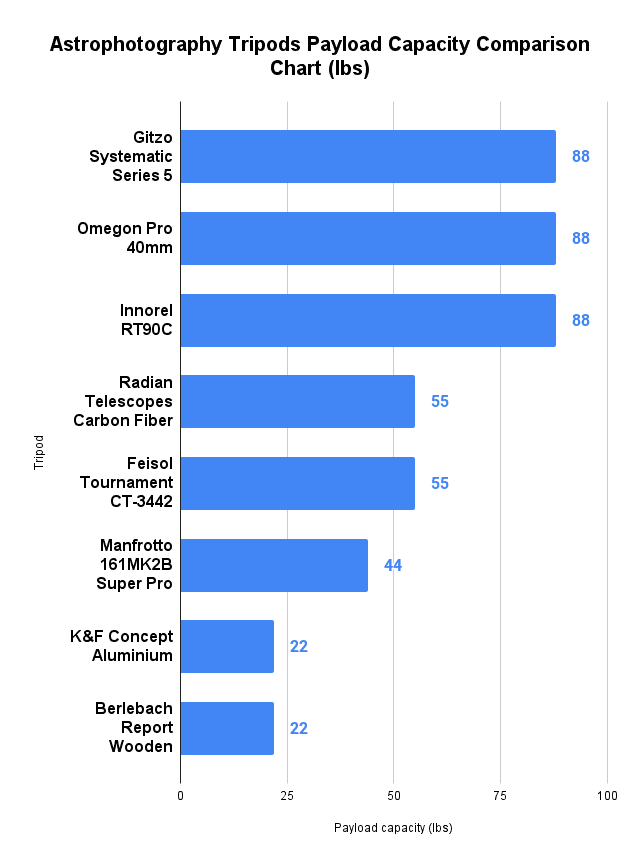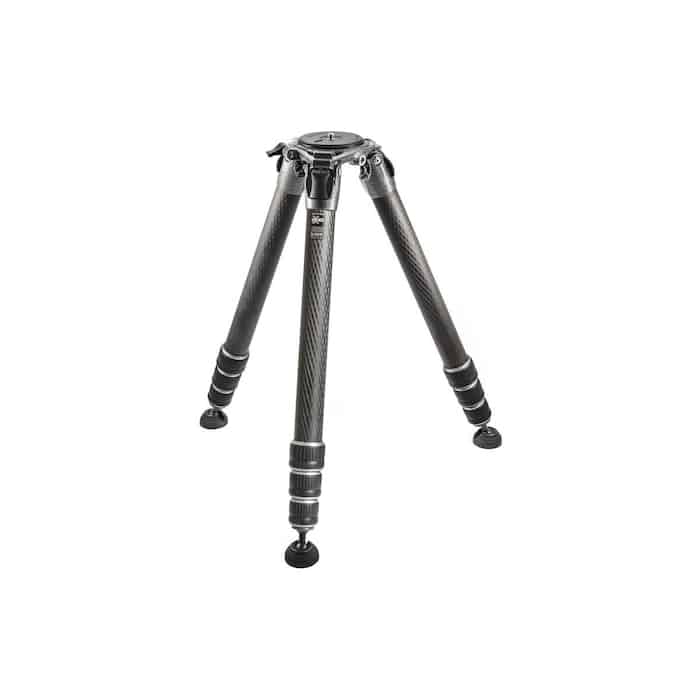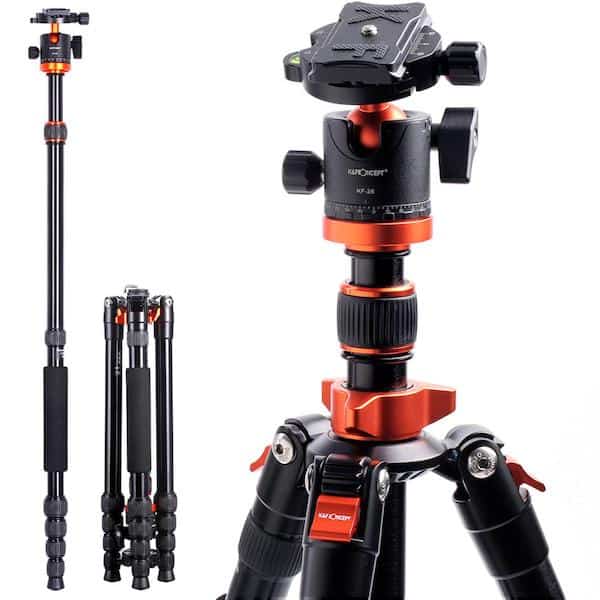For astrophotography, it is absolutely essential to have a quality tripod.
You need to be able to rely on it for complete stability as you take long-exposure shots of the night sky. In this article, we have examined what the options are and recommend the three best options for different budgets.
See below the best details this holiday season or read on for more detail, as well as an overview of what to look for in a tripod for astrophotography.
Gitzo Systematic Series 5 Tripod
Best of the best astrophotography tripod with ultra-high payload capacity
Gitzo is the tripod manufacturer of choice for professional photographers. They are made in Italy and are part of the same group as Manfrotto – another renowned maker of tripods. The Gitzo Systemic tripod is what comes with the Stellina smart telescope.
There are a few different options in the Systematic Series 5 range. This is the 5543 and “the most rigid tripod of the whole Gitzo range”, according to Gitzo themselves. It’s a 4-section carbon fiber tripod.
Pros
- Unbeatable weight carrying capacity at 88 lbs
- Wide rubber feet for stability
Cons
- Expensive – check the prices below but it usually retails for over $1000
- Not that light at 6 lbs, but not so heavy that it would deter you from using it as a travel tripod
Essentially, this is the best of the best when it comes to tripods for astrophotography but it comes at a premium price.
Key specifications
- Material: Carbon Fiber
- Payload Capacity: 88 lbs (40 kg)
- Weight: 6.2 lbs (2.8 kg)
- Height: 61 inches (156 cm)
K&F Concept Aluminium Tripod
Best budget astrophotography tripod
If you are after something in a lower price bracket then this tripod from K&F Concept is a great option.
It boasts the high payload capacity we are looking for whilst being light enough to travel with.
Pros
- Nice and light – lighter even than some carbon fiber tripods
- High payload capacity when compared to similar DSLR tripods in the same price bracket
- Stands tall at 68 inches
- Portable travel/compact tripod that packs away neatly into its bag for easy carrying
Cons
- Primarily a standard DSLR camera tripod and so has features that you won’t really want or need for astrophotography, but you may take advantage of them for regular daytime photography (like using it as a monopod, low-angle shooting, etc.).
- Payload capacity is good for a regular tripod at 22 lbs but you’ll need to ensure your camera and other gear are within that limit.
K&F also offers the same tripod in carbon fiber but we think this aluminum model ticks all the boxes for a budget astrophotography tripod for less than $100.
Key specifications
- Material: Aluminium
- Payload Capacity: 22 lbs (10 kg)
- Weight: 3.4 lbs (1.5 kg)
- Height: 68 inches (175 cm)
Other good tripods for astrophotography
We narrowed it down to three main recommendations above but there are a number of other tripods that are well respected for astrophotography that may be worth considering for you:
- Manfrotto 161MK2B Super Pro Tripod – Manfrotto is a highly respected manufacturer and this is their highest payload capacity tripod.
- Material: Aluminium
- Payload capacity: 44 lbs
- Weight: 17.5 lbs
- Berlebach Report Wooden Tripod – Wooden tripods are great for dampening vibrations from the ground and so perfect for providing stability for astrophotography shooting. Berlebach is the main player when it comes to wooden tripods.
- Material: Wood
- Payload capacity: 22 lbs
- Weight: 7.5 lbs
- Feisol Tournament CT-3442 – Ultra lightweight model from Feisol that is popular with some well-known astrophotographers.
- Material: Aluminum/carbon fiber
- Payload capacity: 55 lbs
- Weight: 2.3 lbs
- Omegon Pro 40mm – Super high payload capacity from this model from Omegon that rivals the Gitzo Systematic Series 5.
- Material: Carbon fiber
- Payload capacity: 88 lbs
- Weight: 8.5 lbs
- Innorel RT90C – Essentially a budget rival to the Gitzo Systematic tripod range that is well-loved by astrophotographers
- Material: Carbon fiber
- Payload capacity: 88 lbs
- Weight: 6.3 lbs
What to look for in an astrophotography tripod
There are a few characteristics of a good astrophotography tripod that can be grouped down to three key elements:
- Versatility & payload capacity: As astrophotographers, ideally you want a tripod that can be used for both landscape astrophotography with a camera/lens/star tracker, and deep sky imaging with a telescope and mount. Can you get this all in one?
- Sturdiness: This is essential. With any astrophotography you are going to be taking long exposures and you need to eliminate any possible camera shake whilst the image is being taken.
- Usability: There are a lot of factors here – how heavy is it to carry, how easy is it to set up and pack away, and how tall does it stand? I.e. how much of a help or hindrance is it when you are out shooting at night?
Let’s look at each of these things in a bit more detail.
Versatility & payload capacity
Standard camera tripods are intended to be used with a camera attached to a ball head. However, for landscape astrophotography, there is a good chance that you are going to want to use it with a star tracker with the camera and lens.
Also, if you are doing deep sky imaging (or plan to) you will need the tripod to carry an astrophotography mount and astrophotography telescope.
The key thing here is the payload capacity – how much weight can the tripod take whilst remaining strong and stable?
Ideally, you have one tripod that can be your only astrophotography tripod used for all these things.
Let’s look at the weight of some example equipment:
Example landscape astrophotography setup
- Canon EOS Ra (camera): 14.5 lbs (6.6 kg)
- Sigma 14mm f/1.8 (lens): 2.6 lbs (1.2 kg)
- Sky-Watcher Star Adventurer (star tracker): 3.7 lbs (1.7kg)
This comes to a total of 20.8 lbs (9.4 kg). With this, you should be aiming for a minimum of 22 lbs payload capacity on the tripod as you don’t want to take it right to the limit. You can get good beginner DSLR tripods in this range (see the K&F Concept tripod below).
Just remember to check your own combined setup weight by giving your camera/lens/tracker a quick google and noting down the weights and doing the quick math. Perhaps also think about if you are likely to upgrade anything in the future.
If used with a GOTO mount and telescope then this will be considerably heavier:
Example deep sky astrophotography setup
- Sky-Watcher EQ6-R Pro (mount): 38 lbs (17 kg)
- Celestron 8″ EdgeHD OTA (telescope): 14 lbs (6.3 kg)
- ZWO ASI1600MM (camera): 1 lb (0.45 kg)
This comes to 53 lbs (24 kg) and you may also have other smaller accessories as part of your setup.
You can see therefore that this is something to pay attention to and if you want a tripod to be an all-rounder for landscape astrophotography and deep sky, then you’ll need to make sure it has the capacity to carry your chosen equipment set up.
Astrophotography tripod payload capacity comparison chart
With that in mind here is a comparison chart of the weight-carrying capacity of the best tripods for astrophotography featured in this article:

Sturdiness: carbon fiber vs aluminum vs wooden tripods
Tripods generally come made in three main materials: carbon fiber, aluminum, or wood. There are advantages and disadvantages to each of these:
- Carbon fiber tripods pros and cons
- Pros
- Lighter and more portable
- Stronger and more durable than aluminum or wooden tripods.
- They will not freeze your hand if touched on cold nights in the way aluminum ones will
- Cons
- The most expensive
- Their light weight means they can be less sturdy
- Pros
- Aluminum tripods pros and cons
- Pros
- Heavier and therefore more naturally stable
- The cheapest
- Cons
- Their heavy weight makes them less mobile
- Feel cold to touch on cold nights
- Pros
- Wooden tripods pros and cons
- Pros
- Boast the best vibration absorption.
- Cons
- Bulkier and so less easy to travel with
- More expensive
- Less commonly available and easy to buy
- Pros
Tripod center columns and astrophotography
Aside from the material, another thing to look for in an astrophotography tripod is for it not to have a center column as this is a source of instability and shake on tripods.
This does mean that the tripod will be shorter, but the trade-off should be worth it. If your tripod does have a center column then you should keep it lowered as far as it can when shooting astrophotography.
Usability
This will depend on how you plan to use the tripod – specifically, will it be mostly fixed in one place (i.e. your backyard), or will it need to be regularly packed up and moved and perhaps taken out on trips?
If you need that convenience and portability then you are going to want a light weight and it being easy to pack up in a bag. In addition, you will value a tripod that is easy to adjust and make changes to how it stands. This will likely mean leaning towards a carbon fiber tripod suitable for travel.
If you don’t need this then you can probably go for a heavier aluminum tripod and get the extra stability from the weight but pay less.
What’s the best tripod head for astrophotography? Ball head, pan tilt head, or gimbal head?
A question that is often asked is what is the best head to use for astrophotography – from ball heads, pan heads, and gimbal heads?
- Ball heads – These attach to your camera and give a wide range of directional movement. If just shooting with a camera, lens and tripod then this is what you want.
- Pan tilt heads – These are primarily for observing with binoculars or small spotting scopes, but not what you want for astrophotography.
- Gimbal heads – These are not generally for astrophotography. They are designed primarily for quick movements needed when capturing fast-moving targets, like birds in flight, and for use with long, heavy lenses having their own tripod mounting points.
So basically you want a ball head for regular photography and beginner landscape astrophotography. However, if you want to advance your landscape astrophotography you will probably want to start using a star tracker to enable you to take much longer exposures.
If you advance beyond this to deep sky astrophotography then you will need to use a full astrophotography mount and astrophotography telescope.
Final word – What do you think is the best tripod for astrophotography?
In summary, our recommendations are:
- If you want the best of the best with the highest payload capacity and have the budget, go for the Gitzo Systematic Series 5 Tripod,
- If you want a cheaper and more basic camera tripod then go for the K&F Concept Aluminium Tripod.
If these aren’t quite right for you or you’re having trouble finding them in stock then have a look at the five alternatives we also listed.
We understand that there aren’t many cheap options recommended here but we think a good tripod is essential for astrophotography and many budget options you might see online will probably not be sturdy enough. This is something worth spending at least a few hundred bucks on to make sure you get something that doesn’t hinder your astrophotography and don’t end up having to buy twice.
We hope that was useful for you. Please let us know in the comments below what you think is the best tripod for astrophotography or if you have any questions.




